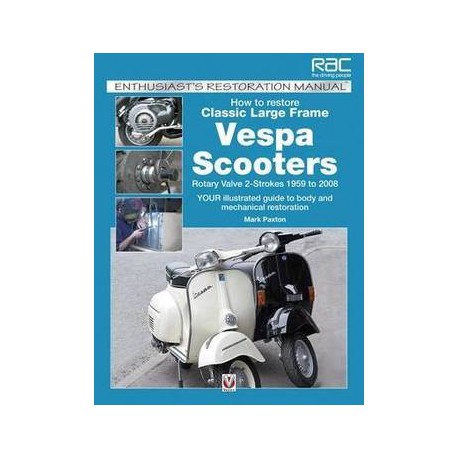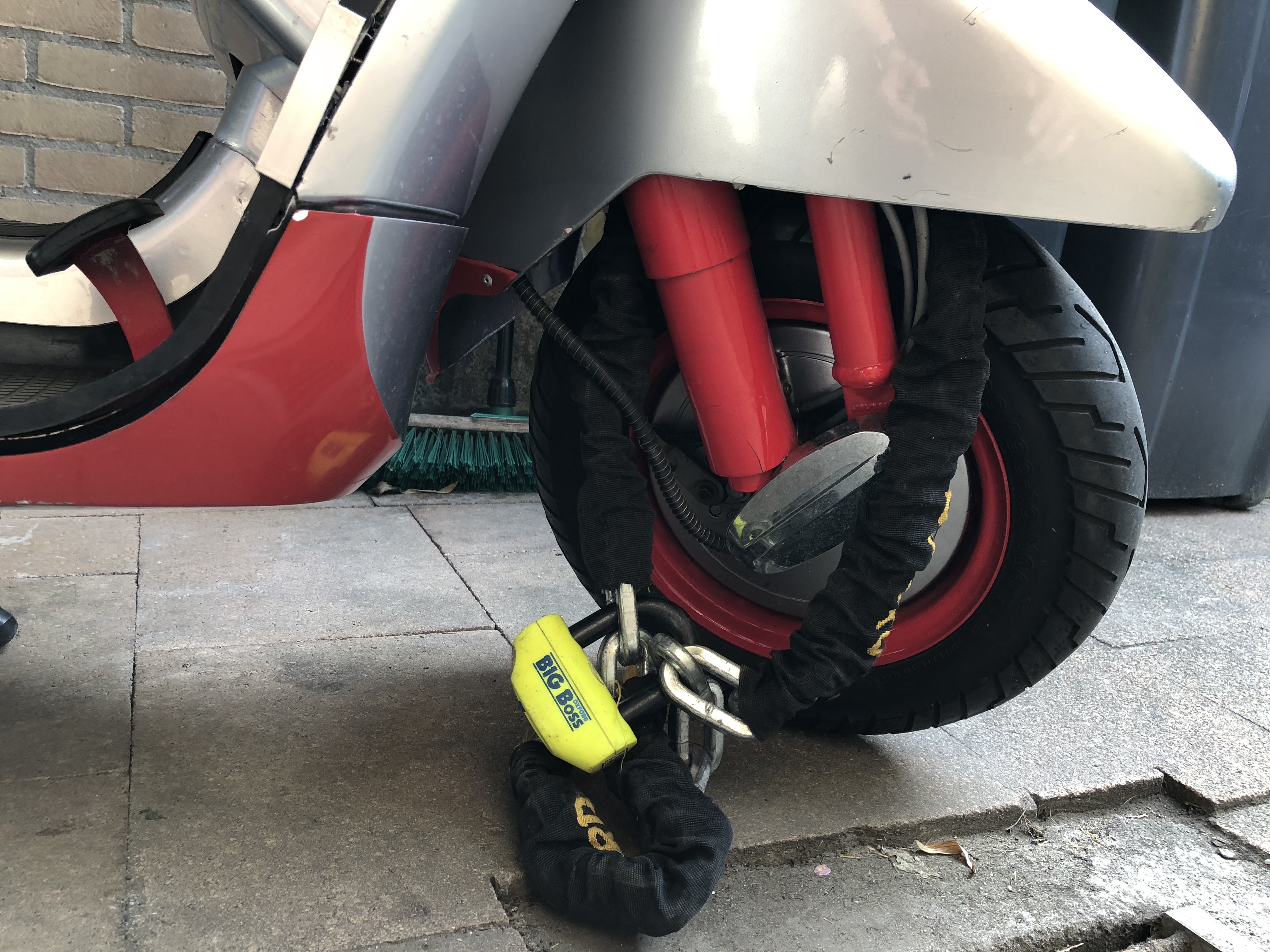Vespa Lx 50 Slot Vervangen

Vespa Lx 50 Manual
Fellas, the clock battery replacement is not so difficult...It takes about 10 minutes max...Cut out a piece of cardboard from a box flap if you are concerned about losing the screws...Use it as a bib placed below your work area...Take out the three main screws...One on each side under the grips, and one just above the headlight...Disassemble the panel...Take the four screws off the back of the panel and unscrew the speedo cable...(I also pulled the communication plugs one each side of the panel...It made it easier to work with the battery hole...)...The battery will be in a hole on the left had side of the panel...Remove the plastic plug and use a small screwdriver to flip the battery out...Reverse the process to reassemble, and you are good to go...
I own Ebeemer Vintage Restoration...We specialize in the procurement of vintage R-Series BMW motorcycles, hard to find parts and parts inventories, and the import/export of all things to do with riding...It is my pleasure to join your forum...If I can help with something, don't hesitate to give me a shout...
Remember, it's all about the ride!...
Jay
I own Ebeemer Vintage Restoration...We specialize in the procurement of vintage R-Series BMW motorcycles, hard to find parts and parts inventories, and the import/export of all things to do with riding...It is my pleasure to join your forum...If I can help with something, don't hesitate to give me a shout...
Remember, it's all about the ride!...
Jay
Vespa Lx 50 2007

Part 2 –Removing the Engine
Once you’ve got the bike stabilized on your work surface (tie-downs are a good idea), the first order of business is to get any trim and plastic out of the way. Remove the “pet carrier”, any rear cowl protectors, and the plastic cowl extensions – which are held in place by two screws in the slots at the front end and plastic tabs at the rear. Be careful pulling them from the front end after the screws are removed, as there are studs in the middle that friction-fit into rubber bushings. If you pull too quickly without slowly working the studs free, the plastic can flex enough to break.
On the left side, you also need to remove the plastic piece that covers the transmission vent pipe under the rear end of the floorboard. Remove the screw I the passenger footrest and pull it out thusly:
Next, remove the exhaust system. First, loosen both Allen-head machine screws that secure the muffler mounting brackets and remove the lower one:
Then, carefully remove the two copper-plated shoulder nuts that secure the exhaust pipe flange to the exhaust port. This will require some creativity with either wobble-end socket extensions or universal joints as the exhaust pipe and swing arm are very much in the way. I use a ¼”-drive ratchet with a 6” wobble extension and a 10 mm socket. Unless you’ve had them off recently, saturating them with some penetrating oil and letting it soak in for a while would probably be a good idea, as you definitely don’t want to break those studs off. They are 7mm studs and are virtually unobtainable. Be very careful not to lose the nuts, too, as they are nearly as hard to find. This pic shows the wrench access problem:
In case you don’t recognize the tube in the upper right of the photo above the ratchet, that is the mounting bracket for my Original Vespa cowl protectors.
Once you have the flange nuts removed, support the muffler and remove the upper Allen-head machine screw from the mounting bracket, and maneuver the exhaust system from the bike.
With the exhaust system out of the way, it is easy to drain the oil:
While you still have the rear brake connected, loosen the rear axle nut. Now you can start disconnecting all the things that connect the engine/transmission to the chassis, like the brake cable:
Cut the cable tie that holds the transmission cooling duct on and remove it:
Remove the spring that supports the back end of the swing-arm, just forward of the oil sump:
Disconnect the throttle cable by unscrewing the bracket and slipping the end slug out:
Label the various hoses and disconnect them from the carburetor and intake manifold:
Then disconnect all the wiring harness connectors to the engine, the connections to the starter motor, and the spark plug cap.
I removed the rear wheel before pulling the engine out, but there is no need to do so if you are just installing the cylinder kit.
Next, support the engine with something to keep it from dropping and remove the hinge bolt from the swing arm bracket:
Disconnect the bottom end of the rear shock from its mounting bracket:
The engine should now be loose from the chassis. As you can see from the next couple of pics, the rear shock is in the way of sliding it out the back unless you jack the rear end of the scooter up really high… even higher if the rear wheel is still on:
Whoops!... forgot to disconnect the vacuum line to the SAS valve!:
OK, the lump is now free to be pulled out and cleaned. Be sure to plug all the hose openings and wrap all the electrical connectors with tape before doing so. Here is the lump soaked down with de-greaser and waiting to be rinsed off with the garden hose:
After it dried, I humped it down into my shop and put it on a clean work surface for disassembly. I used a Black & Decker Workmate I had lying around as a dedicated bench. Watch your back; I’d guess the engine transmission assembly weighs somewhere around 70 lbs.
Coming up next in Part 3, installing the Malossi cylinder kit.
Once you’ve got the bike stabilized on your work surface (tie-downs are a good idea), the first order of business is to get any trim and plastic out of the way. Remove the “pet carrier”, any rear cowl protectors, and the plastic cowl extensions – which are held in place by two screws in the slots at the front end and plastic tabs at the rear. Be careful pulling them from the front end after the screws are removed, as there are studs in the middle that friction-fit into rubber bushings. If you pull too quickly without slowly working the studs free, the plastic can flex enough to break.
On the left side, you also need to remove the plastic piece that covers the transmission vent pipe under the rear end of the floorboard. Remove the screw I the passenger footrest and pull it out thusly:
Next, remove the exhaust system. First, loosen both Allen-head machine screws that secure the muffler mounting brackets and remove the lower one:
Then, carefully remove the two copper-plated shoulder nuts that secure the exhaust pipe flange to the exhaust port. This will require some creativity with either wobble-end socket extensions or universal joints as the exhaust pipe and swing arm are very much in the way. I use a ¼”-drive ratchet with a 6” wobble extension and a 10 mm socket. Unless you’ve had them off recently, saturating them with some penetrating oil and letting it soak in for a while would probably be a good idea, as you definitely don’t want to break those studs off. They are 7mm studs and are virtually unobtainable. Be very careful not to lose the nuts, too, as they are nearly as hard to find. This pic shows the wrench access problem:
In case you don’t recognize the tube in the upper right of the photo above the ratchet, that is the mounting bracket for my Original Vespa cowl protectors.
Once you have the flange nuts removed, support the muffler and remove the upper Allen-head machine screw from the mounting bracket, and maneuver the exhaust system from the bike.
With the exhaust system out of the way, it is easy to drain the oil:
While you still have the rear brake connected, loosen the rear axle nut. Now you can start disconnecting all the things that connect the engine/transmission to the chassis, like the brake cable:
Cut the cable tie that holds the transmission cooling duct on and remove it:
Remove the spring that supports the back end of the swing-arm, just forward of the oil sump:
Disconnect the throttle cable by unscrewing the bracket and slipping the end slug out:
Label the various hoses and disconnect them from the carburetor and intake manifold:
Then disconnect all the wiring harness connectors to the engine, the connections to the starter motor, and the spark plug cap.
I removed the rear wheel before pulling the engine out, but there is no need to do so if you are just installing the cylinder kit.
Next, support the engine with something to keep it from dropping and remove the hinge bolt from the swing arm bracket:
Disconnect the bottom end of the rear shock from its mounting bracket:
The engine should now be loose from the chassis. As you can see from the next couple of pics, the rear shock is in the way of sliding it out the back unless you jack the rear end of the scooter up really high… even higher if the rear wheel is still on:
Whoops!... forgot to disconnect the vacuum line to the SAS valve!:
OK, the lump is now free to be pulled out and cleaned. Be sure to plug all the hose openings and wrap all the electrical connectors with tape before doing so. Here is the lump soaked down with de-greaser and waiting to be rinsed off with the garden hose:
After it dried, I humped it down into my shop and put it on a clean work surface for disassembly. I used a Black & Decker Workmate I had lying around as a dedicated bench. Watch your back; I’d guess the engine transmission assembly weighs somewhere around 70 lbs.
Coming up next in Part 3, installing the Malossi cylinder kit.
Vespa Lx 50 Parts
The best sign-up bonuses at casinos are those that are lucrative, easy to Buddy Slot Vespa Vervangen understand, and do not restrict the betting process. To this end, has put together a list of the best sign-up bonuses offered by the most popular Buddy Slot Vespa Vervangen casinos online. All of these casinos are open to USA players and the sign-up bonuses are clear, concise, and offer the. Vespa Lx 50 Slot, all slots casino mobile, arnold lifeson casino planet 7, blackjack swf. Featured Casino Bonus. Real Roulette with Holly™ Blood Suckers 2. Which slot gives the largest payouts and high RTP? What are the average payouts?